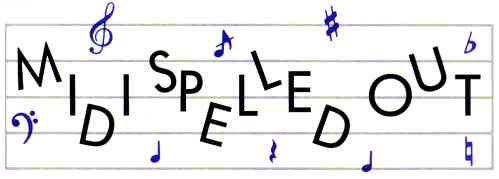
Aftertouch A synthesizer feature in which the keyboard senses the continued pressure on a key as it's pressed.
Breath controller An accessory letting you control musical sounds with a wind instrument-like interface. The harder you blow, the greater the control signal you send.
Cycle 1. One complete occurrence of a waveform, from start to finish (see Waveform). 2. A unit of sound measurement. An instrument that vibrates 120 times in one second is said to have a frequency of 120 cycles per second, or 120 Hertz (Hz). See Frequency.
Envelope The overall configuration of a waveform. If you draw a line around one entire cycle of a waveform, this constitutes a sound envelope. See Waveform, Cycle.
Frequency How often a sound (from either an acoustical or electronic musical instrument) vibrates in one second. The higher the frequency, the higher the pitch.
MIDI Musical Instrument Digital Interface. In 1982 several major musical equipment manufacturers decided upon a set standard, MIDI, for the transferral of sound data from one electronic instrument to another. MIDI-equipped synthesizers can 'talk," or exchange data, with similarly-equipped devices such as drum machines or personal computers. In the case of the latter, you can control many functions of MIDI instruments with specialized software. The MIDI standard provides for 16 channels of communication.
Modulation A way of modifying or adding expression to sounds by altering the waveforms (see Waveform). Many synthesizers have wheel controllers to add modulation to your music.
Note-off velocity When a synthesizer detects how quickly a key is released (the speed of the key rising) and alters the sound of the note accordingly.
Note-on velocity When a synthesizer detects how fast and with what force you are hitting a key, and alters the actual sound of the note accordingly. (Also known as velocity sensitive.)
Patch Editor Software enabling you to alter specific values such as pitch, volume and frequency for the various instrument parameters that make up a synthesizer's musical tones. By altering these values, you can produce a wide variety of sounds. The resultant collection of sound parameters is called a patch. A patch librarian allows you to store patches on disk.
Pitch bend Usually a synthesizer controller (often a wheel) that allows you to move the pitch of a note up or down, within a specified range.
Sequencer Hardware built into a synthesizer, a peripheral or computer software enabling you to input a series of notes for later playback. With a sequencer you can build complicated rhythms to serve as backgrounds for melodies. The best sequencers allow you to edit each note of your sequence, much as you would edit words in a document with a word processor.
Sustain The continuation of a note or sound.
Voices Different channels of sound on a synthesizer. A monophonic synthesizer (which sounds only one note at a time) will have only one voice, whereas a polyphonic synthesizer (which can play multiple notes at once) has several voices.
Waveform The changes in air pressure, measured graphically as a line, as a sound is created. A waveform occurs across a specific range of time and can have several configurations. Waves can have sine (a smooth s), sawtoothed, square or other shapes. If a waveform completes one cycle and returns to its starting configuration, it is called a periodic waveform. See Cycle
Wavelength The distance of a waveform as it completes one cycle. See Cycle.